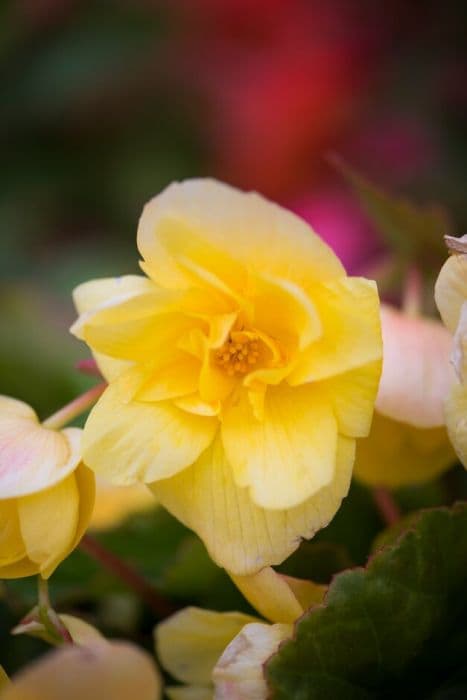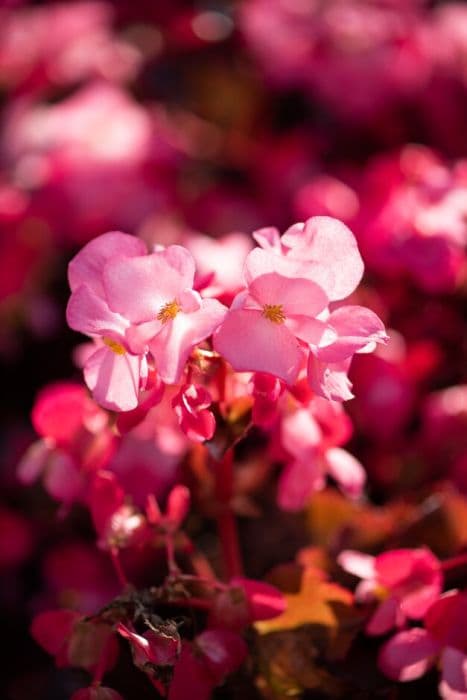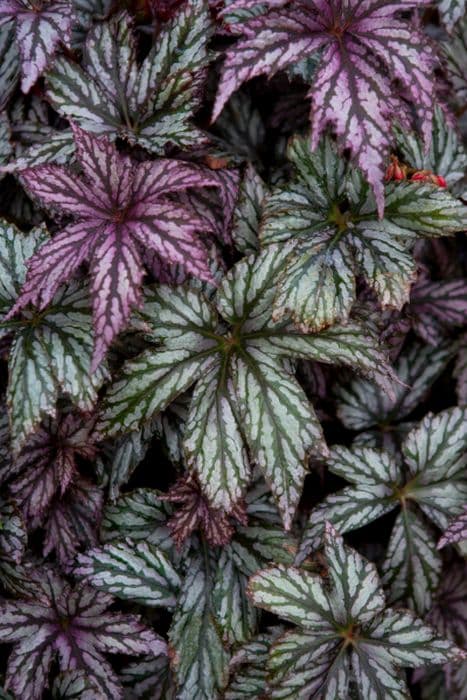Wax Begonia Begonia Cocktail Series

ABOUT
The Begonia Cocktail Series showcases vibrant foliage that brings a burst of color to any garden setting. The leaves of these plants stand out due to their waxy and glossy texture, which catches the light and gives the plant a rich, luscious appearance. Notable for their asymmetrical shape and wing-like appearance, the leaves blend shades of green with deep, darker tones, sometimes accented with a reddish or a maroon edging which provides a stunning contrast. Nestled amongst the striking leaves are the flowers, delicate yet showy, which bloom in a variety of colors, including whites, pinks, reds, and oranges. These blooms can be single or double and are known for their ability to add a bright pop of color throughout their flowering season. The flower clusters sit atop sturdy stems and create a delightful display that can cheer up any space. Overall, the Begonia Cocktail Series plants have a bushy, abundant look with a balanced mixture of bold foliage and cheerful blossoms which exude a tropical flair. These plants are a popular choice for adding vibrancy in gardens, as well as being ideal for containers and hanging baskets where their beauty can be fully appreciated.
About this plant
 Names
NamesFamily
Begoniaceae
Synonyms
Wax Begonia, Bedding Begonia
Common names
Begonia Cocktail Series
 Toxicity
ToxicityTo humans
Begonias, which include the Begonia Cocktail Series, are considered mildly toxic to humans if ingested. Consumption of any part of the begonia can lead to irritation of the mouth, lips, throat, and tongue. In some cases, individuals might experience nausea, vomiting, or salivation. However, serious complications are rare.
To pets
Begonias, such as the Begonia Cocktail Series, are known to be toxic to pets, including both cats and dogs. Ingesting any part of a begonia can lead to symptoms like drooling, vomiting, and difficulty swallowing in pets. These symptoms are due to the soluble calcium oxalates present in the plant. Severe poisoning is unusual, but it is important to keep begonias out of the reach of pets to prevent any accidental ingestion.
 Characteristics
CharacteristicsLife cycle
Annuals
Foliage type
Deciduous
Color of leaves
Varies
Flower color
Varies
Height
1 foot (30 cm)
Spread
1 foot (30 cm)
Plant type
Herb
Hardiness zones
10
Native area
Tropical and subtropical regions
Benefits
 General Benefits
General Benefits- Easy to Grow: The Begonia Cocktail Series is known for being low-maintenance and easy to cultivate, making it suitable for gardeners of all skill levels.
- Vibrant Colors: These plants come in a variety of vivid colors, providing a bright and colorful display in gardens or containers.
- Shade Tolerance: They can thrive in a range of light conditions, including areas that receive partial shade, offering flexibility in garden design.
- Continuous Blooming: Begonias from the Cocktail Series have a long flowering period, often blooming from spring until frost.
- Diverse Landscaping Uses: They can be used in a variety of landscaping applications, such as borders, ground covers, or in hanging baskets.
- Drought Resistance: Once established, they can tolerate periods of drought, reducing the need for frequent watering.
- Pest Resistance: These begonias typically have fewer issues with pests compared to other plants, making them a more resilient choice for the garden.
- Compact Growth Habit: With their compact and controlled growth, they make excellent candidates for smaller spaces or container gardening.
 Medical Properties
Medical PropertiesThis plant is not used for medical purposes.
 Air-purifying Qualities
Air-purifying QualitiesThis plant is not specifically known for air purifying qualities.
 Other Uses
Other Uses- Begonias from the Cocktail Series can be used for educational purposes, such as teaching about plant hybridization and cultivation techniques, due to their variety of colors and patterns.
- Their colorful leaves can be used in art projects like leaf pressing, as they retain vibrant colors and patterns when dried.
- Begonias are sometimes used in fashion, with their distinct foliage inspiring patterns and designs for fabrics and textiles.
- They can serve as natural indicators for a humid environment given their preference for moisture, making them useful for greenhouse humidity monitoring.
- Photographers may utilize Begonia Cocktail Series as subjects for macro photography to showcase the intricate details of their flowers and leaves.
- Begonias can be part of decomposable arts, where their petals and leaves are arranged in patterns that decompose over time and become part of an outdoor landscape design.
- They can be used as a living mulch in mixed plantings, providing ground cover that can help retain soil moisture and deter weeds.
- In creative cooking, some chefs use the colorful petals of culinary-safe Begonia varieties as edible decorations to enhance the visual appeal of dishes.
- The leaves of certain begonias can serve as a biological canvas, allowing for the growth of symbiotic moss or lichen in terrariums or vivariums for a unique cohabitation display.
- Begonias can be part of a stress-relief activity, where the act of caring for and tending to these plants can provide a sense of calm and mindfulness.
Interesting Facts
 Feng Shui
Feng ShuiThe Begonia is not used in Feng Shui practice.
 Zodiac Sign Compitability
Zodiac Sign CompitabilityThe Begonia is not used in astrology practice.
 Plant Symbolism
Plant Symbolism- Beware - Begonias generally carry a cautionary symbolism and the Cocktail Series, because of its vibrant colors, can also signal a warning to be careful in new situations or relationships.
- Harmony - The diverse and balanced hues found in the Begonia Cocktail Series promote a sense of harmony and balance within the home or environment.
- Uniqueness - Each cultivar in the Cocktail Series has its unique coloration, symbolizing the different qualities that make individuals special and reminding us to celebrate our own uniqueness.
- Gratitude - Begonias are often given as a gift to express gratitude, and the Begonia Cocktail Series, with its pleasing aesthetic, is no exception.
 Water
WaterWax Begonias should be watered thoroughly, allowing the soil to dry out slightly between waterings. Use lukewarm water to avoid shocking the plant. Aim to provide approximately one to two inches of water per week, depending on the humidity and temperature conditions. It's important to avoid overwatering, which can lead to root rot. Instead, water the plant at the base to keep the foliage dry and reduce the risk of fungal diseases.
 Light
LightWax Begonias prefer bright, indirect sunlight. They thrive when placed in an east or west-facing window where they can receive ample light without the harsh midday sun. Avoiding direct sunlight is crucial as it can scorch the delicate leaves of the plant.
 Temperature
TemperatureWax Begonias favor temperatures between 60°F and 75°F for optimal growth. They can survive minimal dips down to 50°F but should not be exposed to temperatures below this point. To ensure the health of your Begonia, avoid placing it in areas with drafts or sudden temperature changes.
 Pruning
PruningPruning Wax Begonias encourages bushier growth and more blooms. Trim away any dead or dying flowers, leaves, and stems using clean, sharp scissors. The best time for pruning is late winter or early spring before new growth starts, but cleaning up spent blooms and damaged foliage can be done throughout the growing season.
 Cleaning
CleaningAs needed
 Soil
SoilBegonia Cocktail Series thrives in well-draining soil with high organic matter content; a mix of peat, perlite, and compost works best. They prefer a slightly acidic to neutral pH of 5.5 to 6.5.
 Repotting
RepottingBegonias in the Cocktail series should be repotted every 1-2 years to replenish soil nutrients and accommodate root growth.
 Humidity & Misting
Humidity & MistingWax Begonias, including the Cocktail Series, need moderate humidity levels, around 50%-60%, for optimal growth.
 Suitable locations
Suitable locationsIndoor
Place in bright, indirect light with some humidity.
Outdoor
Shelter from direct sun; keep in dappled shade, moist soil.
Hardiness zone
10-11 USDA
 Life cycle
Life cycleThe life cycle of the Begonia Cocktail Series, commonly known as Wax Begonia, begins with seed germination, where warmth and moisture encourage the tiny seeds to sprout within a week or two under the right conditions. The seedlings rapidly develop true leaves, and within a few weeks, they are ready for transplanting to individual pots or garden spaces, entering the vegetative growth stage. This bushy, fibrous-rooted plant matures and begins to bloom early, often flowering in its first season, especially if grown in ample sunlight with adequate water and fertilizer. The flowering stage is characterized by abundant blooms that can last from spring until the first fall frost, with colors varying from white to pink to red based on the cultivar. As temperatures drop in fall, growth slows, and exposed plants may die back, while those in controlled environments can persist year-round as perennials. If conditions allow, the Wax Begonia can also produce seeds at the end of the flowering cycle, allowing for the natural propagation and continuation of the life cycle.
 Propogation
PropogationPropogation time
Spring-Early Summer
The Begonia Cocktail Series is commonly propagated through cuttings, which is the most popular method for this plant. This process typically occurs in spring or summer when the plant is in its active growth phase. To propagate by cuttings, you would select a healthy stem with a few leaves and cut it just below a node, about 2-4 inches (5-10 centimeters) long. The cut end of the stem should then be dipped in rooting hormone powder and inserted into a pot filled with a well-draining soil mix. The cutting should be kept in indirect light and maintained at a consistent moisture level to encourage rooting. After a few weeks, when the cutting has established a robust root system, it can be transplanted into a larger pot to continue growing.




![Begonia [Devotion]](/_next/image?url=https%3A%2F%2Fplants-admin.emdemapps.com%2Fimages%2Fplants%2F%2Fimages%2F604b58183573b.png&w=640&q=75)




